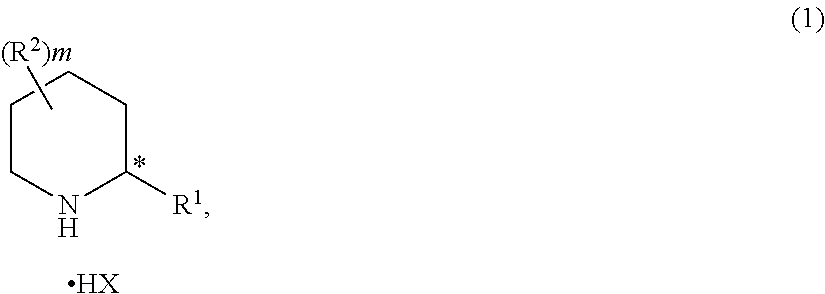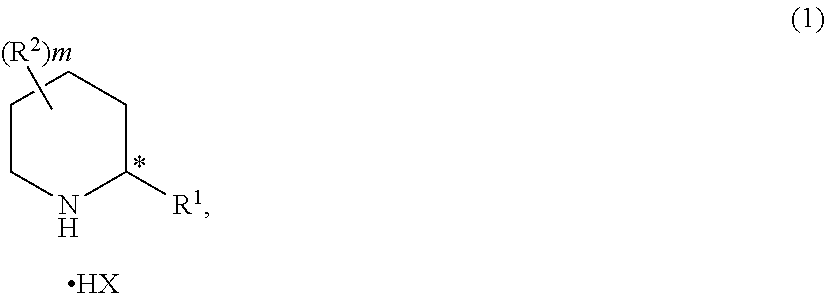Method for producing optically active 2-arylpiperidinium salt
a technology of optically active and arylpiperidinium salt, which is applied in the field of optically active 2arylpiperidinium salt production, can solve the problems of low yield, disadvantageous loss of product, and few technologies known, and achieve the effect of high yield
- Summary
- Abstract
- Description
- Claims
- Application Information
AI Technical Summary
Benefits of technology
Problems solved by technology
Method used
Image
Examples
example 1
Asymmetric Hydrogenation Reaction of 2-Phenylpyridinium Bromide
[0129]To a 100 ml stainless steel autoclave, 14.6 mg (0.01 mmol) of IrHCl(OAc)((R)-DTBM-SEGPHOS) and 118 mg (0.5 mmol) of 2-phenylpyridinium bromide were added, and the autoclave was purged with nitrogen. Then, 2.0 ml of tetrahydrofuran was added thereto. Subsequently, hydrogen was introduced at a pressure of 10.0 MPa, followed by stirring at 80° C. for 16 hours. After cooling, the reaction product was analyzed by GC. The conversion was 91%, and the enantiomeric excess was 52% ee.
example 2
Asymmetric Hydrogenation Reaction of 2-Phenylpyridinium Bromide
[0130]To a 100 ml stainless steel autoclave, 7.6 mg (0.005 mmol) of IrHCl(CF3CO2)((R)-DTBM-SEGPHOS) and 118 mg (0.5 mmol) of 2-phenylpyridinium bromide were added, and the autoclave was purged with nitrogen. Then, 2.0 ml of tetrahydrofuran was added thereto. Subsequently, hydrogen was introduced at a pressure of 5.0 MPa, followed by stirring at 80° C. for 16 hours. After cooling, the reaction product was analyzed by GC. The conversion was 53%, and the enantiomeric excess was 56% ee.
example 3
Asymmetric Hydrogenation Reaction of 2-Phenylpyridinium Bromide
[0131]To a 100 ml stainless steel autoclave, 7.7 mg (0.005 mmol) of IrHCl(C6H5CO2)((R)-DTBM-SEGPHOS) and 118 mg (0.5 mmol) of 2-phenylpyridinium bromide were added, and the autoclave was purged with nitrogen. Then, 2.0 ml of tetrahydrofuran was added thereto. Subsequently, hydrogen was introduced at a pressure of 5.0 MPa, followed by stirring at 80° C. for 16 hours. After cooling, the reaction product was analyzed by GC. The conversion was 38%, and the enantiomeric excess was 53% ee.
PUM
| Property | Measurement | Unit |
|---|---|---|
| optically active | aaaaa | aaaaa |
| optical activity | aaaaa | aaaaa |
| optical resolution | aaaaa | aaaaa |
Abstract
Description
Claims
Application Information
 Login to View More
Login to View More - R&D
- Intellectual Property
- Life Sciences
- Materials
- Tech Scout
- Unparalleled Data Quality
- Higher Quality Content
- 60% Fewer Hallucinations
Browse by: Latest US Patents, China's latest patents, Technical Efficacy Thesaurus, Application Domain, Technology Topic, Popular Technical Reports.
© 2025 PatSnap. All rights reserved.Legal|Privacy policy|Modern Slavery Act Transparency Statement|Sitemap|About US| Contact US: help@patsnap.com



